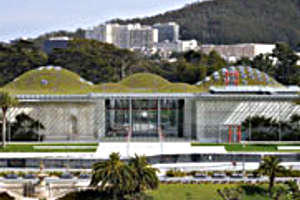 The California Academy of SciencesThe California Academy of Sciences is officially the greenest museum on the planet. LEED, which stands for Leadership in Environmental Engineering and Design, is under the umbrella of the U.S. Green Building Council. It is the benchmark for certification and ranking of green buildings throughout the United States and the world. LEED gave the Academy the highest rating of Platinum for a green building on October 7, 2008. Fifty-two points are needed to for a Platinum rating and the Academy received fifty-four points.
The California Academy of SciencesThe California Academy of Sciences is officially the greenest museum on the planet. LEED, which stands for Leadership in Environmental Engineering and Design, is under the umbrella of the U.S. Green Building Council. It is the benchmark for certification and ranking of green buildings throughout the United States and the world. LEED gave the Academy the highest rating of Platinum for a green building on October 7, 2008. Fifty-two points are needed to for a Platinum rating and the Academy received fifty-four points.
Before starting construction, the Academy was committed to creating a Platinum building to exemplify and embody the Academy mission to explore, explain and protect the natural world. Thirty-four of the fifty-four points were received for the construction of the building. The remaining twenty points were awarded a year after the building was built to ensure that all systems worked effectively. LEED awards its point in the following categories: sustainable sites, water efficiency, energy and atmosphere, materials and resources, indoor environmental quality and innovation and design process. The examples below touch upon the many ways the Academy took on the commitment to a green building and sustainability:
• The new Academy was integrated into the natural environment of Golden Gate Park. The vision of Renzo Piano, the architect of the building, was to lift an acre of the park up and put a museum underneath. His use of light and transparency further reinforces the integration with the park.
• By absorbing rainwater, the new Academy's living roof prevents up to 3.6 million gallons of runoff from carrying pollutants into the ecosystem each year (about 98% of all storm water).
• Over 90% of the demolition waste from the old Academy was recycled. 9,000 tons of concrete were reused in Richmond roadway construction, 12,000 tons of steel were recycled and went to Schnitzer Steel, and 120 tons of green waste were recycled on site. Most of the materials used to build the new building were also sustainable. All the steel in the building was recycled and the insulation within the walls was made from recycled blue jeans.
